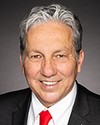We have said a few things about immigration; I will not get into the figures.
Francophones who are immigrants account for about 10% of the Franco-Ontarian community. There are 50,000 to 60,000 newcomers. That is the basis for our survival. Franco-Ontarians spoke to us during the consultations about demographic weight. These 611,500 people represent 4.5% to 5% of the approximately 12 million residents of Ontario. The number of francophones is increasing in each census, primarily due to immigration from other countries or from other parts of Canada.
Sometimes we have immigrants who first arrive in Quebec, in Montreal, specifically. Being unable to find work, they move to Ontario. This poses a problem with respect to funding because it is the initial entry point that receives the funding. If the immigrant changes provinces, the new province does not receive that funding. This is our main demand with respect to immigration. The funding allocated when the immigrant first arrives must follow them when they change provinces. This is crucial for francophone communities.
Ms. Lapointe raised this earlier and I said I would respond. So now I will. In my opinion, IRCC must develop a “franco reflex”. Let me give you a few examples.
When immigrants are recruited abroad—you are familiar with the Canada-Quebec immigration agreement—, francophones from outside Quebec are sometimes part of the delegation and sometimes they are not. The federal government must do more to ensure that francophone communities have some visibility outside of Canada. I call that creating a “franco reflex“ and talking about francophone communities.
I have already given another example. At a meeting, I received a catalogue, available in both official languages, of all the resources available to immigrants. It was a meeting with francophones. I was shown the catalogue and all the resources available. There were a lot of resources, but the official had left the French version of the catalogue at the office. I told him that the corporate image should not be unilingual, in English only. The catalogue should be in both languages, double sided. If one image is projected and the other image is forgotten, it is like forgetting that francophones exist. It is not better than providing a catalogue in French only if the image to be projected is one of linguistic duality. That is important when we are outside the country.
I hope therefore that we can work more closely with the provinces in recruitment initiatives. I know that bilateral discussions must be held in this regard, but Franco-Ontarians must be part of those delegations. Our provincial government made a move recently. With the support of Quebec and New Brunswick, Ontario will become an observer at the International Organization of La Francophonie or the OIF. That will provide a showcase for Franco-Ontarian communities that we do not currently have.
Having a “franco reflex” is one part. I mentioned the very favourable comments by Ms. Chagger and Mr. Saini. They would have wanted to have been told that there are two official languages in Canada and to have heard about the benefits of learning French.
The other part is the economic benefit. As you know, the Conference Board has studied the economic benefits. I am a bit jealous of people in New Brunswick, for example, because they have bilingual call centres in that province. They could have been bilingual in Ontario. We have enough bilingual people but that argument was not made strongly enough.
Promoting linguistic duality at the international level provides an economic benefit for the whole country and for every province. There is a distinct benefit.
As I have often said this morning, the infrastructure in our province is predominantly anglophone.
When it comes to immigration, the welcoming and inclusion of francophones are not easy tasks. Among the groups working in the majority language, there are private agencies that specialize in helping immigrants integrate. That doesn't exist in francophone communities. Those agencies don't do that work in French. However, we have developed abilities to do so through our community organizations.
I will talk to you about the La Passerelle program in Toronto and about CESOQ, here in Ottawa. Those people are working on welcoming francophone immigrants to help them integrate the work community. Improvements are being made. Mr. Hominuk was a member of an expert panel in Toronto. So far, Ontario is the only province that has enshrined a 5% target in its legislation. We hare happy to learn that the deputy ministers of francophone affairs of the provinces outside Quebec recently met in Yellowknife and agreed that all the provinces should work on reaching a target of 5% for francophone immigration outside Quebec. That's a positive development, as there is some synergy. What francophone community groups are lacking is stable funding to help them play that community role.
I have met two or three French people from France who arrived through Toronto's Pearson Airport. However, it took them 18 months to find out that Toronto had a vibrant francophone community. Why did the border officers not tell them that? Why aren't they better connected with francophone organizations? Those are elements we have to take into account.
The other element that must be taken into account is what I would refer to as language training, as newcomers in Canada are concerned about finding work. The language issue aside, they want to work. In Ontario, they clearly must be provided with an opportunity to learn a second language, French, and also some English. We have to be careful about the learning of English. I am talking to you about Ontario as an educator. We have the ability to teach English because our French schools in Ontario are not unilingual. Students who graduate form our high schools are eligible to enrol in any university in the country, in English or in French. Our young people are so successful that we are losing leadership because they end up working internationally.
The training of immigrants in the language of Shakespeare for work should be provided by our francophone establishments. While they're learning the language, immigrants will also get references that will help them become part of the community. For example, are you familiar with Ottawa's Algonquin College? The college provides English as a second language courses for immigrants. However, the classroom references for those students do not come from the francophone community. Conversely, if the course was provided at Cité collégiale, the staff and the environment being francophone, the people learning English would be part of the context of that community, to which they would remain connected.
All too often, we manage to recruit them and bring them into the country, but despite that, three or four years later, they are in English schools and we have lost them. In addition to all the energy we have to expend to reach the 5%, we also have to invest energy into helping retain those people in the communities. They have to establish connections to the communities.
Thank you.





